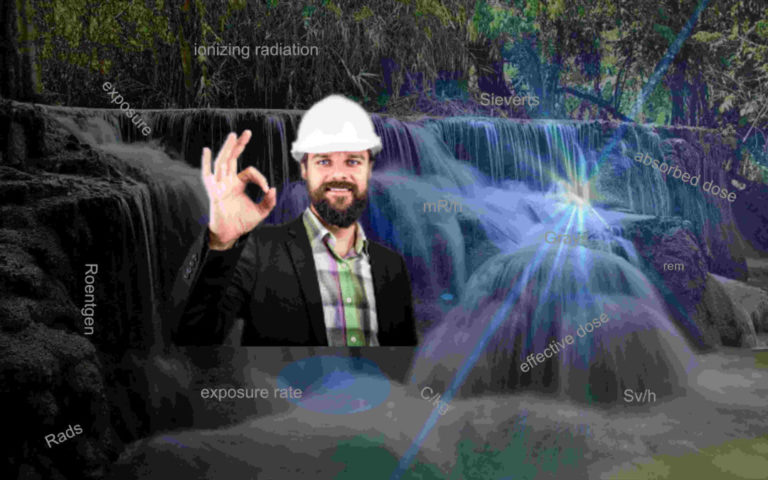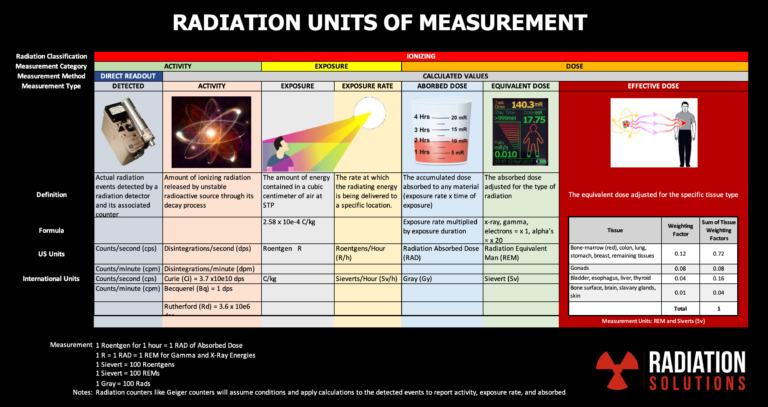Menu

Relating Radiation Measurement Units to Water
If I were attempting to explain radiation measurement units to something even a child could understand, I would liken it to water which I feel really works well as a metaphor. In many ways one can draw simple analogies using water to relate it to radiation.
After completing my previous article Simplified Radiation Measurement for Radiation Safety Officers, I felt I had broken the subject down to its simplest form, but then I had this inspiration to relate water to radiation. As ridiculous as it first sounds, in my mind, it worked surprisingly well.
In the previous article I had developed a chart that presents a great overview or map of the various radiation measurement units along with a more detailed explanation of each. I have included the same chart below to use as a baseline reference for the water analogies I put forth.
I hope this helps those struggling to understand radiation measurement units more readily. Here goes….
Physical Properties
Radiation is a physical property like water that requires different forms of measurement to describe it and to enable its use for our protection. Water is measured by weight, volume, flow rate, temperature, pressure, acidity etc. Similarly, radiation uses Roentgen, Rad, REM, Sieverts, etc.
Different Measurement Standards
Radiation measurements are described by different measurement systems, primarily US and International. In the US we measure water volume in terms of gallons, whereas internationally they use the metric system and liters. So you’ll find two standards used interchangeably.
Water Correlation to
Radiation Measurement Units
Radiation measurements use different terms to describe the energy, rate, and accumulation in a very similar fashion to water. Here’s how the two relate:
Stationary Water Droplet
A droplet is a tiny measure of water. If we forget the hydrogen/oxygen chemistry and science behind all its different forms and just call the droplet the base unit we could easily relate it to the Roentgen, which is a measure of energy in a volume of air.
Streaming Water Droplets
If we take droplets dropping from an eye dropper, rain falling from the sky, or water flowing in a stream, it would represent different levels of our exposure to water droplets. Water streaming from a hose represents one rate of exposure, rainfall another, and a raging stream another. Likewise, radiation Exposure Rate is defined in units that enable us to better understand how much radiation we are receiving or are exposed to. The US unit for exposure to radiation is described as Roentgens per hour (R/h).
Accumulated Water Droplets
As the water droplets accumulate you might receive enough to fill a glass of water, a small pond, or a lake. The accumulated quantity referred to in radiation is called Dose. The unit of dose in the US is called a RAD.
Accumulation of Water Droplet Energies
If water is hitting you with a greater force, the accumulated damage to you will be greater than if it were only trickling in for the same overall volume of water. With radiation, there are different types of radiation, some more forceful than others so the dose type Equivalent Dose (rem) is used to adjust for the added energetic effects.
Water Droplet Absorption Properties
Water is absorbed differently by different materials. Steel is largely impervious to water absorption, but a sponge will absorb many times its own weight. Human absorption/effects/damage by radiation varies by the tissue type. So to accurately describe the effective impact to each type of tissue a weighting factor is applied that results in an Effective Dose (Sv) measurement.
Methods of Measurement
Measurements of water and radiation fall into two categories, detectable and calculated. It’s important to realize that most measurement units are not directly measurable and need to be calculated. Here’s how the two relate.
Detectable
The easiest way to measure the quantity of water droplets is visually count drops as they individually come out of an eye dropper. If we wanted to do this in a more automated fashion without using any of our human senses, we could use a microphone and an electronic counter that listened for each droplet splashing into a container of water and register the number of times droplets fell (counts). Since radiation is not detectable to human senses, we use an electronic counter like a Geiger counter. These rad meters are outfitted with a detector that collect counts every time it senses an interaction with radiation.
Calculated
Some measurements are simply not possible using man-made sensors so they require a representative sample or an indirect measurement as a starting basis. From that initial measurement, various factors and formulae are applied to derive various units of measurement. A good example is determining the waterfall from a rainstorm or other periods of time. A small water gauge in the form of a tube opened to the sky above collects a volume of water as it rains. By measuring how many inches (or fractions of an inch) that is received, you can calculate the water collection in terms of inches/hour, inches/storm, millimeters/day, cc/month etc.
If you wanted to know how much water was streaming inside a ditch, you could begin by measuring the flow rate directly using a flow type instrument. Then by calculating the cross-sectional area of the ditch and multiplying it with the flow rate you arrive at a volumetric streaming rate of gallons/sec, acre-feet/min etc. Radiation measurement units work in similar fashion whereby you can receive a rudimentary count measurement using a rad meter, that can then be applied to a series of factors and formulas to derive the desired measurement.
Conclusion
I hope this brief article helps you to better understand the fundamentals of radiation measurement units. To learn more be sure to also read these two articles:


